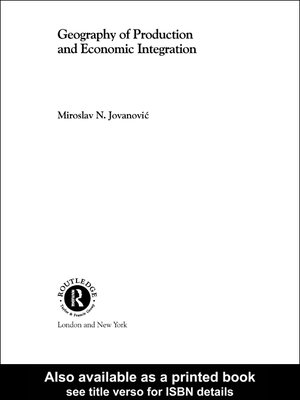Geography of Production and Economic Integration
ebook ∣ Routledge Studies in the Modern World Economy
By Miroslav N. Jovanovic

Sign up to save your library
With an OverDrive account, you can save your favorite libraries for at-a-glance information about availability. Find out more about OverDrive accounts.
Find this title in Libby, the library reading app by OverDrive.



Search for a digital library with this title
Title found at these libraries:
| Library Name | Distance |
|---|---|
| Loading... |
The question of where economic activity will locate in the future is an important issue in present day economics. In all societies each market-orientated firm must make decisions of what to produce, for whom, how and where, in conjunction with the varying levels of economic integration such as discriminatory trade deals, and the growing importance of regionalisation of the world economy.
The traditional neo-classical model of international trade was updated in the 1980s with 'new trade theory' and subsequently by the geography of production in the 1990s. This has deepened our understanding of the basis for and effect of specific locations of industries on trade and vice versa. At the heart of this development are market imperfections such as transport costs, imperfect competition, economies of scale, production differentiation and sunk costs. Nonetheless, the new spatial economics is in its pioneering phase and it is still a formidable task to formulize a mix of numerous market imperfections that shape the geography of production. This book discusses the way in which economic integration and preferential trade agreements reinforce or alter the existing location of industries. Using a conceptual approach with real life examples, the author seeks to clarify and explain the key tendencies of the relationship and influence between spatial distribution of production and economic integration.
Geography of Production and Economic Integration will develop students', specialists' and policymakers' understanding of this highly topical subject.
The traditional neo-classical model of international trade was updated in the 1980s with 'new trade theory' and subsequently by the geography of production in the 1990s. This has deepened our understanding of the basis for and effect of specific locations of industries on trade and vice versa. At the heart of this development are market imperfections such as transport costs, imperfect competition, economies of scale, production differentiation and sunk costs. Nonetheless, the new spatial economics is in its pioneering phase and it is still a formidable task to formulize a mix of numerous market imperfections that shape the geography of production. This book discusses the way in which economic integration and preferential trade agreements reinforce or alter the existing location of industries. Using a conceptual approach with real life examples, the author seeks to clarify and explain the key tendencies of the relationship and influence between spatial distribution of production and economic integration.
Geography of Production and Economic Integration will develop students', specialists' and policymakers' understanding of this highly topical subject.







